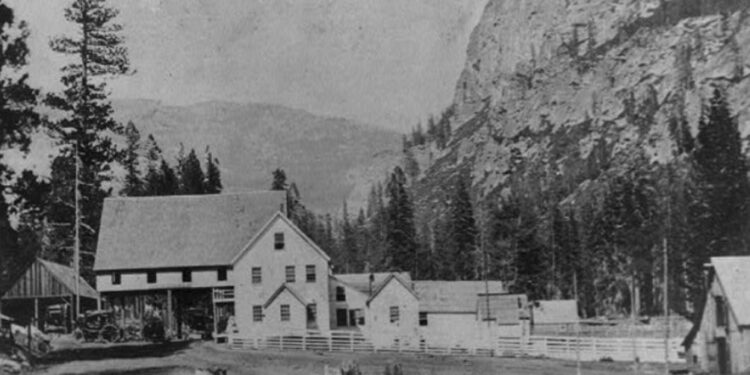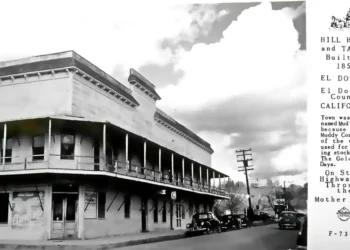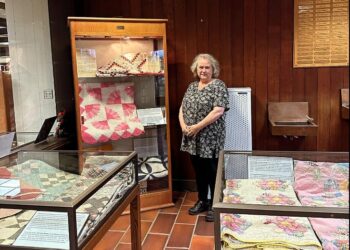(InEDC) BY Cris Alarcon Published: September 17, 2023
The history of Strawberry, California is truly fascinating. From its origins as “Mutual Gold Diggings” to becoming a beloved tourist destination, this small community has seen it all.
Strawberry is a small community nestled in the Sierra Nevada Mountains on Highway 50 in El Dorado County, California. It has a rich history that dates back to the 1800s. Originally known as “Mutual Gold Diggings,” the area was later renamed “Strawberry Valley” due to the abundance of wild strawberries that grew there. This name change reflected the natural beauty and allure of the region.
Strawberry’s history is closely tied to the California Gold Rush of the mid-1800s. Along the banks of the cascading American River on Highway 50, this historic lodge was once a stop for the Pony Express. As more miners settled in the area, known as Strawberry Valley, the town began to flourish. Schools, churches, and businesses were established, creating a vibrant community. The transformation of Strawberry into a summer resort spot for city dwellers was a pivotal moment in its history. The development of lodges, cabins, and campsites allowed visitors to immerse themselves in the natural beauty of the Sierra Nevada Mountains. Fishing, hiking, swimming, and camping became popular activities, creating unforgettable memories for generations of tourists.

Although mining declined over time, Strawberry continued to attract visitors due to its picturesque setting and proximity to the American River. Outdoor enthusiasts flocked to the area to escape the city and enjoy the beauty of the Sierra Nevada Mountains. The town became a popular summer resort spot for city dwellers from Sacramento and the Bay Area in the early 20th century. Lodges, cabins, and campsites were developed to accommodate the influx of tourists, solidifying Strawberry’s reputation as a recreational destination.
However, Strawberry faced setbacks throughout its history, including devastating wildfires and floods. Despite these challenges, the community demonstrated resilience and managed to preserve its allure and natural beauty.
The original Strawberry stood on Highway 50, west of Strawberry Market, before it burned down in the 1860s. The subsequent iteration of the town, which the Lincoln Highway passed by, was visible in a black and white photo. The building was located on the old Swan-Henry Toll Road and Strawberry Court off the present-day Highway 50.
In the 1940s, a new large building, now recognized on Highway 50, was constructed, and the Strawberry General Store attached one of their Lincoln Highway signs to the distance tree at the front of their building. The town continued to adapt and evolve as a tourist destination and a close-knit community.

Today, Strawberry retains its charm and allure as a community known for its outdoor recreational opportunities. Visitors can enjoy camping, hiking, and skiing at the nearby Sierra-at-Tahoe resort, formerly known as the Sierra Ski Ranch. The present-day Strawberry Lodge, built in 1939, stands as a testament to the town’s rich history. Its iconic sign stretched over the road was erected to entice drivers along the new Highway 50, which bypassed the previous Strawberry when the road was re-routed away from the old Lincoln Highway.
Strawberry‘s journey through time is a testament to the resilience and adaptability of the people who inhabited the Old West. Irad Berry, a pioneer from upstate New York, established a stage stop and feed station in Strawberry, California. With the help of Powell Crosley, Berry went on to build the most impressive hotel on the overland trail from Placerville to Virginia City, drawing in a steady stream of travelers and miners.
During the silver rush, Strawberry thrived as the liveliest spot on the old Placerville Road. The inn provided essential services such as feed for horses, meals for miners, and accommodations for weary travelers. However, with the decline of the silver mines and the completion of the transcontinental railroad, Strawberry’s fortunes dwindled, and it became a ghost town.
But the story didn’t end there. Pioneer stagecoach driver Charlie Watson took over in 1865 and rebuilt the inn after a devastating fire. The inn saw another resurgence under the ownership of Norma Scherrer, who added amenities like a swimming pool, dance hall, and cabins. However, the Great Depression and the relocation of the highway caused financial difficulties for the Scherrers, leading them to bankruptcy.
In 1939, Fred Baumhoff, a gold dredger who had struck it rich in Idaho, purchased the property and fulfilled his lifelong dream of building a lodge. Baumhoff later sold the lodge to Otto Schaffer in 1942, who transformed it into a thriving resort by adding a golf course for summer and skiing for winter, taking inspiration from Sun Valley, Idaho.

The journey of Strawberry Lodge reflects the ebb and flow of fortune in the Old West. It tells of early settlers seeking their fortunes, the rise and fall of mining towns, and the resilience of those who adapted to changing circumstances. Today, Strawberry Lodge stands as a testament to the enduring spirit of the American frontier.


![Grizzly Flat [ca. 1851-1852]](http://www.inedc.com/23/wp-content/uploads/2023/11/GrizzlyFlats-1851-1852-120x86.webp)

![Grizzly Flat [ca. 1851-1852]](http://www.inedc.com/23/wp-content/uploads/2023/11/GrizzlyFlats-1851-1852-350x250.webp)





